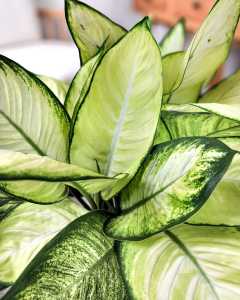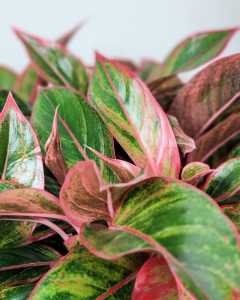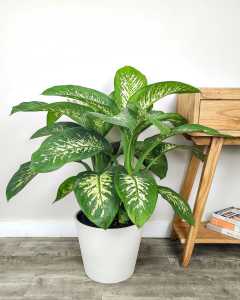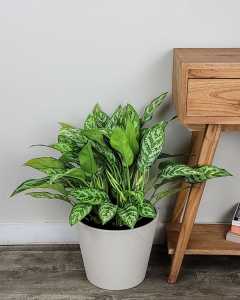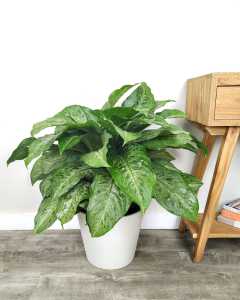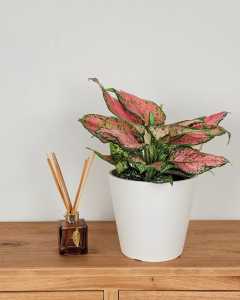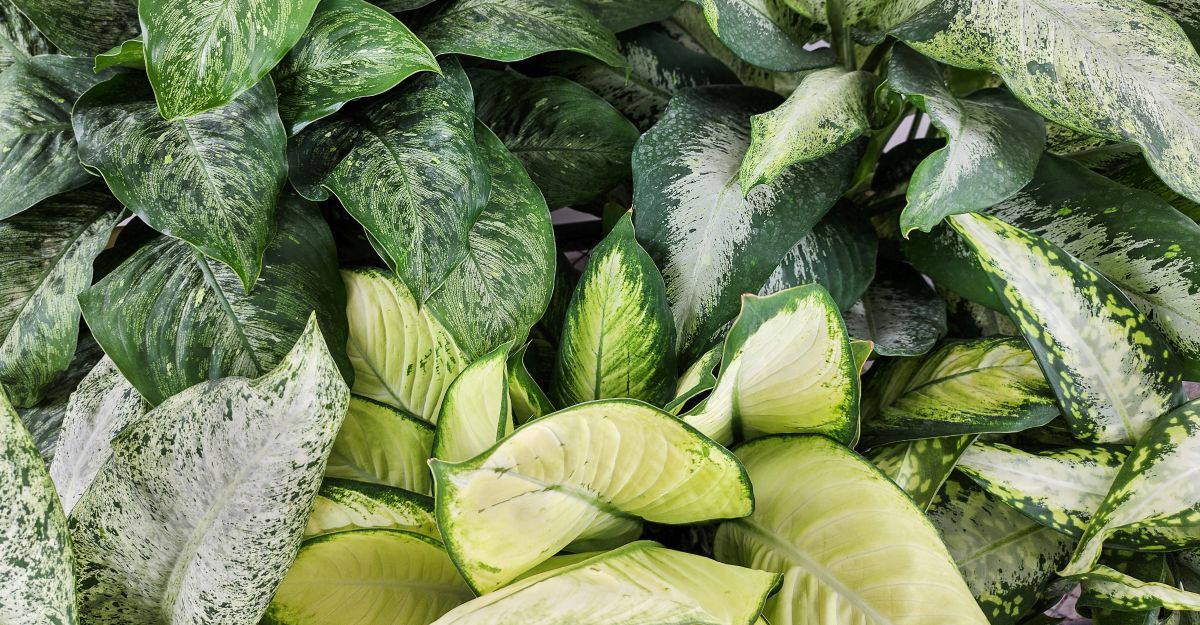
If you’ve ever found yourself staring at a Dieffenbachia and an Aglaonema, wondering which one is which, you’re not alone. These two tropical beauties share some similarities—lush foliage, easy care, and serious air-purifying power.
But don’t be fooled!
They have distinct personalities, and today, we’re breaking down their differences so you can choose the perfect plant for your space.
Foliage & Appearance
 Dieffenbachias (a.k.a. Dumb Canes)
Dieffenbachias (a.k.a. Dumb Canes)
Are known for their bold, dramatic foliage. These plants have larger, broader leaves with a more pronounced central vein, with stunning variegation that can feature shades of green, white, cream, or yellow markings that often create a mottled or splashed effect.
The leaves have a softer texture compared to Aglaonemas, and their size contributes to the plant’s bold, tropical appearance. As the plant matures, the lower leaves may shed, exposing its thick cane-like stems.
 Aglaonemas (a.k.a. Chinese Evergreens)
Aglaonemas (a.k.a. Chinese Evergreens)
Are a bit more subtle but equally beautiful. Their leaves are typically smaller and more elongated with a variety of color patterns, including silver, green, red, and pink variegation.
The foliage often has a glossy or waxy surface, giving the plant a sleek appearance. Different Aglaonema varieties exhibit unique variegation, with some featuring speckled, marbled, or striped designs. The leaves tend to grow in a more compact and symmetrical arrangement, contributing to the plant’s bushy appearance.
If you’re looking for a plant with a softer, more elegant vibe, Aglaonemas are the way to go.
Toxicity: Keep an Eye on Those Leaves!
One major thing to note—both Dieffenbachias and Aglaonemas are toxic if ingested by pets or small children.
Aglaonemas
While mildly toxic if ingested, they are generally safer than Dieffenbachias. The sap contains calcium oxalate crystals, which can cause mild irritation if chewed or ingested by pets or humans. However, the effects are usually less severe than those caused by Dieffenbachias.
Dieffenbachias
Highly toxic to pets and humans if consumed, their sap contains a higher concentration of calcium oxalate crystals. This can cause severe irritation, swelling, and a temporary loss of speech if ingested, hence the name “Dumb Cane.” Handling the plant without gloves may also cause skin irritation in some individuals.
Light & Care Needs
Both plants are easygoing, but they do have some preferences when it comes to care.
 Dieffenbachias
Dieffenbachias
Love bright, indirect light but can tolerate lower light conditions.
If placed in too much direct sunlight, their leaves can scorch, leading to brown edges or faded variegation. On the other hand, too little light can result in leggy growth and a loss of vibrancy in their leaf patterns.
They enjoy evenly moist soil, so don’t let them dry out completely between waterings.
 Aglaonemas
Aglaonemas
On the other hand, are practically the MVPs of low-light conditions. They thrive in low to moderate indirect light, making them perfect for shaded corners.
Some variegated varieties, especially those with lighter-colored leaves, may require slightly more light to maintain their vibrant patterns.
However, they are highly adaptable and can tolerate artificial lighting, making them great choices for spaces with limited natural light, making them perfect for offices or low-light rooms.
They also prefer slightly drier soil between waterings, making them more drought-tolerant than Dieffenbachias.
Growth Habit
Aglaonemas
Generally, they have a slow-growing, compact, and bushy habit, making them ideal for small spaces and tabletops. They tend to remain close to the soil, spreading outward rather than growing tall. Some newer cultivars, however, may exhibit slightly more upright growth.
Dieffenbachias
They grow faster and taller, often developing a central cane-like stem that gives them a tree-like appearance over time. They can reach heights of 3 to 6 feet indoors, depending on the variety. If the lower leaves drop, the plant may need occasional pruning to maintain its shape and fullness.
Watering Needs
 Dieffenbachias
Dieffenbachias
They require more consistent moisture and can suffer from drooping if they dry out too much. While they do not like to sit in soggy soil, they appreciate regular watering to keep their foliage lush. It is best to maintain evenly moist soil, ensuring proper drainage to prevent root rot.
 Aglaonemas
Aglaonemas
These plants prefer to dry out slightly between waterings and are more tolerant of occasional neglect. Overwatering can lead to root rot, so it is best to allow the top inch or two of soil to dry out before watering again. They are generally forgiving if a watering is missed, making them a good choice for busy plant owners.
Temperature and Humidity Preferences
Aglaonemas
Prefer warm temperatures (65-80°F) and moderate humidity but can adapt to drier indoor conditions. While they thrive in higher humidity, they are more resilient in less humid environments compared to Dieffenbachias. A pebble tray or occasional misting can help maintain optimal conditions.
Dieffenbachias
Thrive in warm, humid environments (65-85°F) and may require additional humidity to prevent leaf browning. They are more sensitive to dry air, which can lead to crispy leaf edges. Using a humidifier or misting regularly can help maintain their lush appearance.
Pests and Diseases
Aglaonemas
Relatively resistant to pests but can sometimes attract spider mites, mealybugs, or scale. Wiping the leaves with a damp cloth and occasionally applying neem oil can help prevent infestations.
Dieffenbachias
More susceptible to common houseplant pests such as spider mites, aphids, and mealybugs. Their broad leaves provide an ideal surface for pests to settle, so regular inspections and proper air circulation can help minimize issues.
Which One Should You Choose? It all comes down to your space and style!
Do you want a plant that stands out? Id, Patterned leaves?
Go for a Dieffenbachia!
Need a resilient, low-light plant that’s effortlessly stylish?
Aglaonema is your best bet!
Can’t decide? Get both! They complement each other beautifully and bring variety to your indoor jungle.
No matter which one you choose, both of these tropical plants will bring life, color, and a touch of the rainforest into your home. Happy planting!

